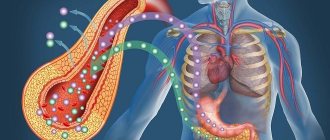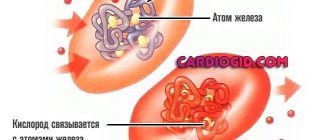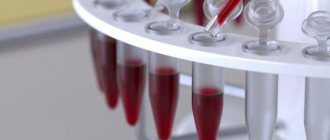What is included in general blood biochemistry
A comprehensive laboratory examination includes many tests. In practice, not all, but only some of them are used for a general assessment of blood composition. They are considered basic. Advanced tests are prescribed according to individual indications.
Basic biochemical indicators include nitrogenous bases, proteins, sugars, lipids, pigments, enzymes and electrolytes.
Normal values in adults
The main values characteristic of a healthy body can be summarized in one table. The norm is different for men and women. Decoding a biochemical blood test in adults includes a comparison with the data provided. If one or more indicators differ from those presented in the table, the doctor must find out the reason for the identified deviations.
Table of blood biochemistry norms for adults:
Reference values for children
Biochemical blood test indicators differ significantly depending on age. To evaluate the results, children are conditionally divided into the following groups: up to 1 month, up to 1 year and from one year to 14 years. Normal values for these categories are averages.
Interpretation of chemical blood bioanalysis for different age groups:
What does a biochemical blood test show?
There are advanced and general therapeutic standards of biochemical analysis. The general therapeutic standard includes the study of basic indicators of human blood components, which can reveal disorders occurring in the heart, urinary, endocrine or digestive systems, and the presence of inflammation in the liver tissue.
The main indicators include:
- total protein;
- aspartate aminotransferase (AST);
- alanine aminotransferase (ALT);
- direct and total bilirubin;
- urea;
- glucose;
- cholesterol;
- creatinine;
- electrolytes.
The advanced analysis tests additional enzymes necessary to clarify the diagnosis:
- c-reactive protein;
- globulins;
- ferritin;
- fructosamine;
- lipoproteins;
- vitamins;
- microelements.
Kidney function tests
To assess the functioning of the urinary system, 3 tests are performed: analysis for creatinine, urea and uric acid. These substances are metabolic products and should normally be completely eliminated from the body. If an excess is detected, kidney problems are likely. An accurate conclusion can only be made based on the combined assessment of all three indicators.
Creatinine
The content of this substance in the blood of a healthy person is relatively stable. An increase indicates the presence of chronic or acute renal failure, water imbalance, or excessive meat consumption. A decrease in blood creatinine occurs during treatment with glucocorticoids, insufficient muscle mass or gestosis in pregnant women.
Urea
An unnecessary product of protein metabolism, excreted by the kidneys in the urine. Its elevated level indicates conditions characteristic of an increase in creatinine. The difference is that deviations of urea from the norm mean a long course of the disease. High levels may indicate starvation or hypertension. The decrease occurs due to inflammation of the pancreas, infection with worms, and poisoning with toxic substances.
Uric acid
A dangerous sign of the development of gout is an increase in this purine breakdown product. Uric acid is synthesized by the liver and excreted by the kidneys, so its level characterizes the functioning of both of these organs. High values indicate abuse of alcohol and fatty foods, and thyroid disease. Low levels warn of severe liver damage, tumors and even AIDS.
Blood collection
The nurse takes blood for laboratory tests using a syringe from a vein. Most often, this requires the ulnar vein, but this can also be done from any other vein. The procedure itself will take very little time, and every nurse knows how to correctly take a blood test for biochemistry. The procedure will not cause any particularly unpleasant sensations. For the study, 5 ml is usually sufficient. Sometimes several different types of tests are required, and in this situation it is acceptable to dial 20 ml. at one time. How much such an analysis will cost and how many days the biochemistry is performed must be found out directly in the laboratory itself.
The results obtained after the analysis must be transferred to the attending physician, who will report the presence or absence of any abnormalities.
We are all designed in such a way that it is very difficult to wait for a consultation with a doctor, and we will most likely try to figure out the indicators on our own. Next, we will try to decipher the biochemical blood test, but here it is extremely important to remember that only a qualified specialist will be able to correctly evaluate the data obtained and only after a series of additional studies will make a final diagnosis.
Glucose tolerance test
Sugar in blood biochemistry helps detect diabetes at an early stage. Carbohydrates include glucose, seromucoids and fructosamine. Both an increase and a decrease in sugar levels are dangerous for humans. If there is an excess of carbohydrates, doctors suspect brain injuries or tumors, prediabetic conditions, oncology, and endocrine pathologies. Low glucose levels may indicate nutritional deficiencies, food allergies, or an overactive pancreas.
Indicators of lipid metabolism or cholesterol levels
Lipids play an important role in cell life. They are involved in the construction of the cell wall, the formation of bile, many hormones (male and female sex hormones, corticosteroids) and vitamin D. Fatty acids are a source of energy for organs and tissues.
All fats in the human body are divided into 3 categories:
- triglycerides or neutral fats;
- total cholesterol and its fractions;
- phospholipids.
In the blood, lipids are found in the form of the following compounds:
- chylomicrons - contain mainly triglycerides;
- high-density lipoproteins (HDL) - contain 50% protein, 30% phospholipids and 20% cholesterol;
- low-density lipoproteins (LDL) - contain 20% protein, 20% phospholipids, 10% triglycerides and 50% cholesterol;
- very low-density lipoproteins (VLDL) - formed during the breakdown of LDL, include a large amount of cholesterol.
The greatest clinical significance in the analysis is total cholesterol, LDL, HDL and triglycerides (see blood cholesterol levels). When taking blood, you should remember that violating the preparation rules and eating fatty foods can lead to significant errors in the analysis results.
What causes lipid metabolism disorders and what can this lead to?
| Why does cholesterol rise? | Why is it decreasing? |
Total cholesterol
|
|
Triglycerides
|
|
Degrees of increased cholesterol in the blood:
- 5.2-6.5 mmol/l – mild degree of increase in the substance, a risk zone for atherosclerosis;
- 6.5-8.0 mmol/l – a moderate increase, which is corrected by diet;
- over 8.0 mmol/l – a high level of a substance requiring medicinal intervention.
Depending on changes in lipid metabolism, 5 clinical syndromes, so-called dislipoproteinemias, are distinguished (1,2,3,4,5). These pathological conditions are harbingers of serious diseases, such as cerebral atherosclerosis, diabetes mellitus and others.
Liver function analysis
The functioning of the largest gland in the body is assessed based on 5 parameters. These include total and direct bilirubin, alkaline phosphatase, alanine aminotransferase (ALT) and aspartate aminotransferase (AST). When interpreting test results, the degree of deviations from the norm is taken into account. A comprehensive evaluation of all liver tests is necessary for an accurate diagnosis.
Alkaline phosphatase
In the body, an enzyme that speeds up chemical reactions is found in many tissues. Its biological role is to transport phosphorus. The maximum concentration is observed in the liver. An increase in the enzyme in the blood may indicate puberty, pregnancy, or recovery from injury. A significant increase is observed with lesions of the liver and biliary tract. Reduced values indicate vitamin deficiency and hormonal disorders.
ALT
This indicator of biochemical analysis characterizes the functioning of the liver and heart. Its concentration in the blood is assessed along with other enzymes. A significant excess of normal clinical values may indicate acute hepatitis. For additional information about organ damage, its relationship with other liver markers is calculated.
AST
The enzyme is found in the heart muscle, liver, lungs, kidneys and nervous tissue. An increase may occur due to a malfunction of one of these organs. The most common causes are cirrhosis, hepatitis, myocardial infarction. A low level of AST or even its absence in the blood is considered normal, but can warn of hypovitaminosis or extensive liver damage.
Bilirubin
A yellow pigment formed during the breakdown of hemoglobin. An increase in blood bilirubin is a sign of liver pathologies. The most common of these are cholelithiasis, tumors, cirrhosis and hepatitis. A decrease in bilirubin occurs rarely, but indicates serious illness. These include leukemia, tuberculosis, lupus erythematosus, diabetes, and aplastic anemia.
Biochemistry - when the indicators are normal
Blood for analysis is taken from a vein. The following parameters are assessed in the laboratory:
- Hemoglobin and haptoglobin. Hemoglobin serves as a carrier of oxygen in the body. It's good to have 120-130 grams per liter. If the number is lower, anemia is suspected. "Haptoglobin" changes as a person ages. The norm is haptoglobin up to 1750 mg per liter.
- Glucose. Above 6.1 millimoles per liter is the reason for sending the subject to an appointment with an endocrinologist.
- Urea and residual nitrogen. The norm of biochemistry is when the urea level is not higher than 8.3 millimoles per liter. An excess indicates possible kidney dysfunction. Residual nitrogen should range from 14.3 to 28.6 millimoles per liter.
- Lipids. A total blood level of no more than 8 grams per liter is considered normal.
- Cholesterol. Less than 5 mmol is recommended. If cholesterol is more than 7.8 millimoles, we can talk about atherosclerosis. In this case, a more extensive examination is prescribed.
- Triglyceride. This indicator directly depends on the age of the subject. The figure should be within the range of 2.71.
- Phospholipids. It’s good when phospholipids are in the range of 2.52 – 2.91.
- Pancreatic secretion. The norm for lipase is 190 units. An indicator exceeding this figure indicates a disease in the pancreas.
- If biochemistry reveals rheumatoid antibodies, this indicates an autoimmune disease.
- The presence of C-reactive protein will indicate the occurrence of an inflammatory process in the body.
When undergoing biochemical analysis, it is important to know that each laboratory uses different research methods, so the results may vary. It is better to entrust the correct deciphering of the biochemistry result to the attending physician.
Blood fat
The analysis evaluates the lipid profile, which includes cholesterol and its fractions. Deviations from the norm can warn of life-threatening conditions. The doctor prescribes a lipid profile to identify the risk of cardiovascular diseases. The group of tests includes measuring the level of total cholesterol, high and low density lipoproteins, and triglycerides.
Total cholesterol
A lack of blood fats is just as dangerous as their excess. Cholesterol is necessary for the normal functioning of the entire body, so its level is one of the most important indicators of a biochemical blood test. Increases often occur due to poor nutrition and low activity. To find out the exact cause, an analysis of the level of all cholesterol fractions is required.
LDL
Low-density lipoproteins are called bad cholesterol because they form plaques on the walls of blood vessels and cause atherosclerosis. An increase in blood LDL serves as a signal for changing your lifestyle, reviewing your diet, and giving up bad habits. If this is not done, the risk of stroke, hypertension and other problems with the heart and blood vessels will increase significantly.
HDL
Good cholesterol helps process fats from food and remove LDL from the body. A low level of lipoproteins of this type is more dangerous than an elevated one. With a lack of HDL, the risk of cardiovascular disease increases. The reasons for the decrease in HDL in the blood are malnutrition, alcoholism, infections, tumors, inflammation, and hormonal disorders.
Triglycerides
Neutral lipoproteins come with food or are synthesized by the body independently from sugar and alcohol. Their high level while simultaneously reducing good cholesterol leads to atherosclerosis. An increase in triglycerides is often observed in older people and pregnant women. Other causes include taking hormonal drugs, overeating, and alcoholism.
How to get tested
A biochemical blood test is done in the morning on an empty stomach. The material is taken from the patient’s vein. Before taking the test, it is important to follow several rules so that your results are as accurate as possible:
- Rule 1. You cannot eat for at least 8 hours before taking blood.
- Rule 2. You cannot drink alcohol for at least 7 days before the test.
- Rule 3: You cannot smoke for at least 1 hour before donating blood.
These are the three basic rules. We can add to these that all factors that may affect the results of the analysis must be reported to the doctor, these include:
- Taking medications.
- Taking contraceptive medications.
- Heavy physical activity.
- Work in hazardous production.
- Stressful situations.
- Presence of chronic diseases.
- Having allergies.
- The presence of hereditary pathologies.
Today, blood biochemistry can be done in any laboratory. You can donate blood for analysis both at a local clinic and at a private diagnostic center. The only difference is the cost of the analysis and the timing of the results. At the clinic you will not have to pay for the test, but the result will be given to you in 2-4 days, and you yourself need to go to the medical institution to get the laboratory form.
Private clinics offer more convenient, but paid conditions for testing.
For a small fee, the test results will be sent to you by email, after which you can print out the form and bring it to your doctor's appointment. Deciphering the results will not take much time from a specialist.
Thyroid tests
All vital processes depend on the health of the endocrine system. The thyroid gland is one of the largest hormone-producing organs. It produces thyroxine and triiodothyronine (T3 and T4). The thyroid gland is very sensitive to the influence of external and internal factors. Even minor changes will affect the test results.
Thyroid-stimulating hormone
TSH has a direct effect on the thyroid gland. This hormone is produced in the pituitary gland. It gives a signal for the production of T3, T4. A lack of TSH is observed when taking hormonal drugs, as well as in tumors and autoimmune diseases. An increase in thyroid-stimulating hormone occurs due to pituitary tumors, lead poisoning, or mental disorders.
T3 and T4
Thyroxine and triiodothyronine are responsible for metabolic processes and control the functioning of the reproductive and digestive systems. Thyrotoxicosis (excess T3 and T4) often occurs due to increased TSH production. Rare causes include pituitary adenoma, thyroid cancer, and medications. Toxic goiter, exhaustion of the body, and inflammation of the endocrine gland lead to a decrease in the level of T3 and T4.
What is the normal level of electrolytes in the blood with BAC?
By taking a laboratory biochemical blood test, you will also receive indicators of potassium and sodium - the two most important electrolytes found in human blood. Although their concentration in the human body is insignificant, electrolytes perform important actions in all chemical processes in our body.
Let's look at each of them separately:
- Potassium The most important of the microelements, which takes a large part in enzyme processes, conducting electrical impulses directly to the heart. Any changes in composition and deviations from the norm are negative and have a detrimental effect on the myocardium.
Hyperkalemia is an upward deviation of potassium. Hypokalemia is a reduced state.
Having noticed high levels of potassium in a biochemical blood test, you should know that the consequences are unpleasant: a decrease in pulse, loss of consciousness, a drop in pressure, disturbance of the senses. Indicators above 7.10 mmol/l pose a threat to the body.
A decrease below 3 mmol/l is dangerous. With potassium deficiency, the following symptoms are expressed: weakness in the heart area, as well as in the muscles, vomiting and others.
- Sodium ( Na) As such has no effect in metabolism. It is stored in a liquid located outside the cells. Its main task is to maintain normal blood pressure levels. The level of sodium in the body is controlled by a hormone secreted by the adrenal cortex. This trace element is excreted in the urine. Hypernatremia is a significant increase in sodium concentration. Symptoms of high sodium saturation are: cramps throughout the body, sharp pain in the head, nausea, complete apathy, even coma is possible. A low level of this electrolyte is hyponatremia. It is manifested in symptoms: strong and constant thirst, body cramps, mild irritability, tremors in muscle tissue (possibly twitching), and even coma.
- Magnesium ( Mg) No less important electrolyte than the previous ones; when values fall below 0.7 mmol/l, it is noticed with peritonitis, intestinal obstruction, constant vomiting and loss of large amounts of fluid by the body. An increase in their levels above 1.2 mmol/l carries the same danger.
- Chlorine ( Cl) Acceptable values are 95-110 mmol/l. And the symptoms are similar to sodium.
- Calcium (Ca)
A trace element that is responsible for muscle contraction, normalization of cell membranes and is responsible for the quality of bone tissue. If the value is below 2.2 mmol/l, then this is possible with hypothyroidism, low intake of food into the body, or rickets. Which can lead to weakness of muscle tissue, arrhythmia. An increase above 2.75 mmol/l usually occurs with hyperfunction of the parathyroid glands and pancreatic necrosis.
- Vitamin D ,
- Vitamin C , called ascorbic acid,
- Iron ( Fe) This element is the main part that makes up hemoglobin,
- Zinc ( Zn) Acute lack of this element in the body inhibits growth and sexual development. It also helps to enlarge the liver and spleen. Causes anemia.
The quantitative indicators of each of the electrolytes are very important for general health, although their concentration in relation to other blood elements is small.
Protein in the blood
Of the more than 150 proteins contained in plasma, about 10 types are studied during LHC. Their synthesis occurs in the liver, so deviations from the norm indicate problems in this organ. Biochemical blood test indicators include total protein and its main fractions. When preparing for the test, keep in mind that protein levels change under the influence of many factors.
Total protein
The concentration of albumin and globulin in the serum reflects the body's ability to maintain a constant internal environment (hemostasis). When total protein increases, the blood thickens. This may occur due to the development of tumors, inflammation or infections. A lack of protein indicates hormonal imbalances or digestive problems.
Albumen
The content of simple proteins in the blood also characterizes the state of functioning of internal organs. Albumin is synthesized by the liver and makes up up to 80% of all proteins. A very high level indicates intestinal obstruction, poisoning, cholera. The decrease occurs due to a low-protein diet, due to peptic ulcer disease or pancreatitis.
Preparing for the test
In order for the clinician to receive the most reliable information when interpreting the results, preliminary preparation for a biochemical blood test is necessary, which includes the following rules:
- The last meal should be taken 12 hours before the collection of biological fluid - this means that such a study is carried out only on an empty stomach.
- The day before the test, you should stop drinking coffee, strong green or black tea.
- Follow a gentle diet for 3 days before visiting a medical facility. It is recommended to avoid fatty, fried and spicy foods. Adults are also advised to eliminate bad habits.
- The day before the test, it is necessary to reduce physical activity.
- Refusal to take medications several weeks before the expected date of the clinic visit. If for any reason it is not possible to do this, then it is imperative to inform the hematologist about this.
- On the day of the diagnostic test, you should exclude the influence of stressful situations, emotional arousal and nervous tension, as this may distort the results.
About 10 minutes before a biochemical blood test is performed, the person needs to calm down to normalize breathing and heart rate.
It should be noted that young children do not need preparation for a blood test. In addition, it is not necessary for patients in serious condition. At the same time, it is best to go for a biochemical study in the first half of the day - in the morning. Biochemical blood test and preparation for it are two inseparable concepts.
Electrolytes
Positively or negatively charged particles formed during the breakdown of acids, alkalis, and salts in the blood. The main electrolytes are potassium, sodium, chlorine, calcium, magnesium. These particles provide many processes in the body. The level of electrolytes characterizes the functioning of the kidneys and heart. Deficiency is often observed in young children and the elderly.
Sodium and potassium
Deviations in the amount of electrolytes from the norm occur due to a number of reasons. A decrease in sodium indicates uncontrolled diabetes, liver disease, or pneumonia. An increase indicates poor kidney function and a decrease in the volume of urine excreted. Potassium increases with renal failure, and decreases due to prolonged vomiting and diarrhea.
Calcium
The most abundant mineral in the body, it has many functions. Calcium is responsible for the transmission of nerve impulses, heartbeat, and blood clotting. A decrease in mineral content indicates problems with the endocrine system or stomach. The reasons for the increase are tumors, kidney failure, and a sedentary lifestyle.
Chloride ions
Electrolyte imbalances often occur due to kidney failure. Chlorides depend on the sodium level, increasing or decreasing with it for the same reasons. Excess in the blood is observed during fever, diabetic coma, and a strict diet. A decrease in chlorine occurs during uncontrollable vomiting, diarrhea or increased sweating.
Carbon dioxide
Its amount in the body is regulated by the kidneys and lungs. Changes in carbon dioxide content characterize the functioning of these organs. An increase in the blood of this substance leads to poisoning. Causes may include loss of consciousness or pulmonary disease. When carbon dioxide levels are low, hypoxia occurs, which develops against the background of panic attacks or after taking certain medications.
Interpretation of analyzes
The obtained LHC tests should be read by a laboratory diagnostics physician or the attending physician. Having received the blood test data, it is the doctor who, seeing the problematic issues, will prescribe a number of additional tests and examinations. The doctor will take into account the difference in standards for men, women and children. If necessary, the patient will be prescribed additional consultations with other doctors. Only after the picture of pathological disorders becomes completely clear will the patient be given a final diagnosis.
Despite the fact that anyone can donate blood for biochemistry on their own, although you will have to pay for it, in no case should you self-diagnose or self-medicate. As can be seen from our analysis of blood components, a change in the same indicator can indicate completely different pathologies, and only knowledge of the totality of deviations from the norm will allow the doctor not to make a mistake.
Thus, even if a person independently paid for the biochemical analysis, he definitely needs to consult a doctor, especially if it concerns a child.









